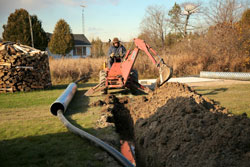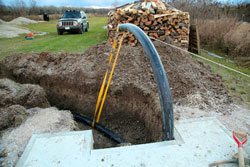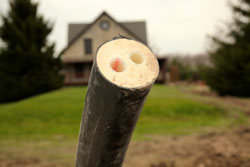As winter descends on us Canadians again, I’m reminded how heating technology is virtually a life support system for almost half of each year in our part of the world. And with so much of our heating (and our lives) based in some way on fossil fuels, this spells trouble on two counts. Besides the apparent environmental implications of adding tons of new carbon to the atmosphere per person each year, fossil fuel prices will continue to trend upwards over time as rising international demand chases oil reserves that are harder and less productive to develop. Even now, fossil fuel prices are capping economic growth and making us vulnerable to everything from destructive weather events to questionable foreign governments. There is, however, an alternative to keeping warm in winter, and it springs from technology that’s widespread in Europe and catching on much more now in Canada than the US. It’s called district energy, and it’s a system that I’m gaining personal experience with right now in a small way.
 District energy systems use central plants to produce and direct hot water for heating surrounding buildings and also, in some cases, cold water for cooling in summer. This water is pumped through underground pipes to buildings large and small. The genius of centralizing the production of heat like this means that a whole range of different fuels can be used, with the main focus on burning biomass. Organic waste, farm-raised energy crops and wood chips are all options, depending on what makes sense given local conditions. Even waste heat from industrial processes can be fed into district heating systems. Regardless of the source of heat energy, it’s always used to produce hot water. This is transferred to buildings large and small via insulated underground pipes, where it’s then used mostly for space heating. In many Nordic countries, virtually all buildings are connected to district energy systems like this, both large commercial installations and individual homes. 93% of all buildings in Helsinki, for instance, are connected to district energy plants, the product of a municipal courage that began way back in 1953.
District energy systems use central plants to produce and direct hot water for heating surrounding buildings and also, in some cases, cold water for cooling in summer. This water is pumped through underground pipes to buildings large and small. The genius of centralizing the production of heat like this means that a whole range of different fuels can be used, with the main focus on burning biomass. Organic waste, farm-raised energy crops and wood chips are all options, depending on what makes sense given local conditions. Even waste heat from industrial processes can be fed into district heating systems. Regardless of the source of heat energy, it’s always used to produce hot water. This is transferred to buildings large and small via insulated underground pipes, where it’s then used mostly for space heating. In many Nordic countries, virtually all buildings are connected to district energy systems like this, both large commercial installations and individual homes. 93% of all buildings in Helsinki, for instance, are connected to district energy plants, the product of a municipal courage that began way back in 1953.
This early adoption in parts of Europe is especially impressive when you realize how challenging district energy systems are to implement. They’re typically massive community projects requiring bold, future-oriented government leadership. A good part of the trouble springs from the disruption caused by digging trenches for the underground pipes required. These pipes are the unsung heros of the entire venture because they’re key to the efficiency of the system. Besides the obvious fact that these pipes must remain reliably leak-free for decades, they also need to keep insulation dry in potentially wet soil conditions. It’s not as simple as it sounds, and the challenges have led to some innovative Canadian technology.
 Urecon developed a unique process to create insulated pipes in their Montreal plant back in 1972, and this Canadian success story is one reason district heating is so technically possible and energy efficient today. For reasons that continue to puzzle me though, new district heating projects are currently much more common in Canada than they are even in cold regions of the US. Carl Vreugde, district energy manager with Urecon, tells me you’ll find new district energy installations in Markham (Markham District Energy), Toronto (Regent Park Community Energy System), Calgary (Enmax District Energy Centre), Prince George, Victoria (Dockside Green), Quebec City (Cite Verte), Charlottetown PEI and several locations in and around Vancouver. A small project is even unfolding right now in my own backyard.
Urecon developed a unique process to create insulated pipes in their Montreal plant back in 1972, and this Canadian success story is one reason district heating is so technically possible and energy efficient today. For reasons that continue to puzzle me though, new district heating projects are currently much more common in Canada than they are even in cold regions of the US. Carl Vreugde, district energy manager with Urecon, tells me you’ll find new district energy installations in Markham (Markham District Energy), Toronto (Regent Park Community Energy System), Calgary (Enmax District Energy Centre), Prince George, Victoria (Dockside Green), Quebec City (Cite Verte), Charlottetown PEI and several locations in and around Vancouver. A small project is even unfolding right now in my own backyard.
While most district energy involves communities on a municipal level, it’s also an option for rural properties. Any day now I’ll be firing up the clean-burning, outdoor wood furnace I’ve installed for heating my house, my workshop and the domestic hot water for both buildings. Insulated underground pipes are key to this system, and the technology involved is more advanced than I expected.
 The pipe I used is called Logstor PEX-Flex. It’s made in Denmark, one country of several that are at the leading edge of district energy technology. PEX-Flex comes in different sizes, and the kind I used is 4 1/2 inches in diameter on the outside, made with three main parts. The outer husk of the pipe is continuous and waterproof. Inside this pipe are two smaller pipes, each about 1 inch in diameter. One of these delivers hot water to buildings from the outdoor furnace, and the other brings cooler water back to the furnace for reheating. The space between inner and outer pipes is filled with closed cell polyurethane foam insulation. The whole arrangement is so effective that 180ºF water entering one end of the pipe loses only a degree or two of temperature after traveling 100 feet.
The pipe I used is called Logstor PEX-Flex. It’s made in Denmark, one country of several that are at the leading edge of district energy technology. PEX-Flex comes in different sizes, and the kind I used is 4 1/2 inches in diameter on the outside, made with three main parts. The outer husk of the pipe is continuous and waterproof. Inside this pipe are two smaller pipes, each about 1 inch in diameter. One of these delivers hot water to buildings from the outdoor furnace, and the other brings cooler water back to the furnace for reheating. The space between inner and outer pipes is filled with closed cell polyurethane foam insulation. The whole arrangement is so effective that 180ºF water entering one end of the pipe loses only a degree or two of temperature after traveling 100 feet.
Efficiency rarely comes easily, and the way we keep warm in winter is changing. District energy holds lots of promise for large Canadian communities, and even tiny installations like my own. In both cases, it always boils down to simple, high-tech pipes that are a lot more sophisticated than they look.